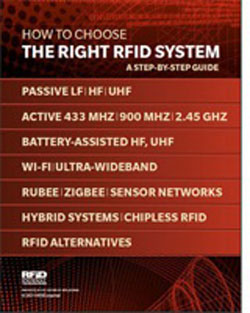RFID Journal announced today that it has published a new report, entitled “How to Choose the Right RFID System: A Step-by-Step Guide.” This 40-page publication explains the differences between many types of radio frequency identification technology, including passive, active, battery-assisted, ultra-wideband (UWB), Wi-Fi, ZigBee, hybrid and chipless—and also discusses which type of system is best for particular applications.
“I get many questions from readers about which type of RFID would be appropriate for a business problem they are trying to solve,” says Mark Roberti, RFID Journal‘s founder and editor. “As those questions have become more common, I realized we should provide a single document that walks people through the decision-making process, so they have an idea of what solution will work best, and which technology providers are able to help them.”
The report is divided into nine sections:
Part 1: The Major Types of RFID Systems
Part 2: A Step-by-Step Guide to Choosing the Right RFID System for Your Application
Part 3: The Different Types of Passive RFID Systems
Part 4: The Different Types of Active RFID Systems
Part 5: Battery-Assisted RFID Systems
Part 6: Hybrid RFID Systems
Part 7: RFID Sensor Networks
Part 8: Chipless RFID Systems
Part 9: Alternatives to RFID
An appendix lists common RFID applications, the type of system most commonly used for each, and links to news articles about those applications on RFID Journal‘s Web site. A separate appendix lists numerous RFID vendors, broken down by the type of technology offered. The report also includes a table listing 27 different types of RFID technology, the air-interface protocol employed for each system, and each technology’s read range, location accuracy and tag cost.
The goal of the report is to provide end users and others with a single document explaining all of the different types of RFID systems, along with what each does and does not do well.
“No RFID system does everything,” Roberti says. “Choosing the wrong solution requires companies to make compromises that can affect the efficiency and utility of their RFID system, or cause a project to fail altogether. Our goal is to help businesses choose the proper system for the right application, without spending a lot of time and labor testing different types of RFID.”
The report is available for purchase through the RFID Journal Store, and is included with the purchase of an All-Access Conference Pass to RFID Journal LIVE! 2011, being held on Apr. 12-14, 2011, at the Orange County Convention Center, in Orlando, Fla.


